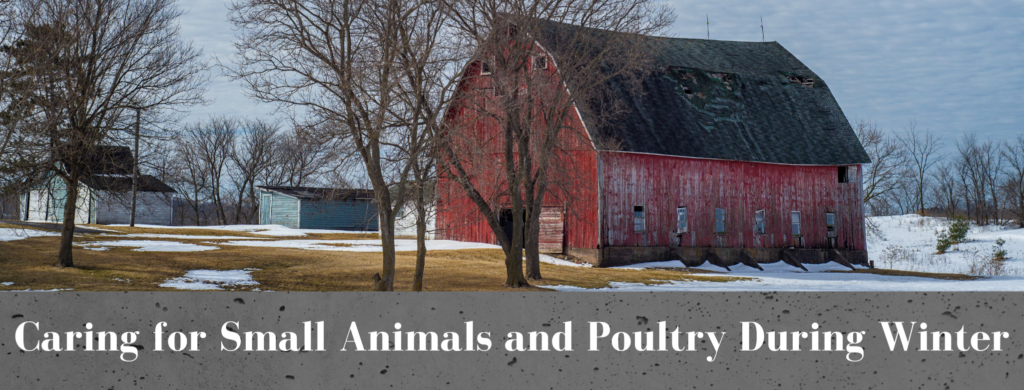Caring for Small Animals and Poultry During Winter
go.ncsu.edu/readext?835962
en Español / em Português
El inglés es el idioma de control de esta página. En la medida en que haya algún conflicto entre la traducción al inglés y la traducción, el inglés prevalece.
Al hacer clic en el enlace de traducción se activa un servicio de traducción gratuito para convertir la página al español. Al igual que con cualquier traducción por Internet, la conversión no es sensible al contexto y puede que no traduzca el texto en su significado original. NC State Extension no garantiza la exactitud del texto traducido. Por favor, tenga en cuenta que algunas aplicaciones y/o servicios pueden no funcionar como se espera cuando se traducen.
Português
Inglês é o idioma de controle desta página. Na medida que haja algum conflito entre o texto original em Inglês e a tradução, o Inglês prevalece.
Ao clicar no link de tradução, um serviço gratuito de tradução será ativado para converter a página para o Português. Como em qualquer tradução pela internet, a conversão não é sensivel ao contexto e pode não ocorrer a tradução para o significado orginal. O serviço de Extensão da Carolina do Norte (NC State Extension) não garante a exatidão do texto traduzido. Por favor, observe que algumas funções ou serviços podem não funcionar como esperado após a tradução.
English
English is the controlling language of this page. To the extent there is any conflict between the English text and the translation, English controls.
Clicking on the translation link activates a free translation service to convert the page to Spanish. As with any Internet translation, the conversion is not context-sensitive and may not translate the text to its original meaning. NC State Extension does not guarantee the accuracy of the translated text. Please note that some applications and/or services may not function as expected when translated.
Collapse ▲
With winter comes cold temperatures and damp weather, both being undesirable for small animals and poultry. Efforts need to be made to ensure the best possible care for outdoor small animals (rabbits) and poultry. Below are some easy methods of preventing sickness, frostbite, and other conditions that commonly accompany winter weather.
- Shelter is essential for any animal, especially small animals and poultry. Without shelter, the animals are exposed to the elements and will have to utilize all their energy to stay warm and functional. Animals without shelter will become frostbite and sick. This can result in production loss or even death. The shelter needs to have at least three walls and a space where the animal can escape the wind and moisture. A shelter can be anything from a plastic container with a cut opening to a dog house.
- Footing for small animals and poultry is important for health and production. Often small animals and poultry are housed on wire, which can cause injury or death when exposed to the elements and water. Provide each animal with a solid, non-metal surface to remove themselves from the wire at their leisure. This allows the animals to limit their exposure and limit the chance of injury. Solid surfaces such as a hardwood board, blanket, box with bedding, or plastic box top will work.
- One of the five required nutrients for any animal is water. This is required for the animal to remain healthy. During winter, water can freeze, limiting the animal’s access and ability to consume adequate amounts. Ensure that all animals and poultry have access to water that is replenished daily and is clean and clear of ice. Heating methods are available and highly suggested. Heaters come in many forms and prevent freezing but can evaporate water quickly. To avoid a dry trough and freezing, provide animals and poultry with bulk waterers that have the ability to be heated safely.
For more information, please contact Michelle South at the N.C. Cooperative Extension, Mitchell County Center at 828-688-4811.



